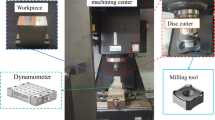Abstract
Intermetallic iron–aluminum (FeAl) has an excellent resistance against corrosion and abrasion, a low density as well as high specific strength compared to conventional steel. In addition, the raw materials and manufacturing costs of FeAl-alloys are relatively low. The machinability is challenging. Economical machining of FeAl-alloys is currently not possible because of high tool wear. The chip formation mechanisms in machining FeAl-alloys are currently unknown. This study focuses on the influence of the material grain size on the thermomechanical processes during chip formation. A simultaneous measuring system for the determination of process forces, temperatures and chip formation in planing and orthogonal turning is presented. The chip formation mechanisms change with the grain transition and grain size. Decreasing grain sizes lead to the higher ductility in material separation by favorable thermomechanical loads and reduced crack initiation. By using force data from monocrystalline machining a model is introduced, which predicts the force dynamics in machining of polycrystals.













Similar content being viewed by others
References
Sykes C, Bampflyde JW (1935) The physical properties of iron–aluminum alloys. J Iron Steel Inst 130:389–418
McKamey CG, DeVan JH, Tortorelli PF, Sikka VK (1991) A review of recent developments in Fe3Al-based alloys. J Mater Res 6:1779–1805
Pint BA, Leibowitz J, DeVan JH (1999) The effect of an oxide dispersion on the critical Al content in Fe–Al alloys. Oxid Met 51:181–197
Morris DG (1997) Overview of iron–aluminide research in Europe: organization and examples. In: Deevi SC, Sikka VK, Maziasz PJ, Cahn RW (eds) International symposium on nickel and iron aluminide. ASM International, Materials Park, Ohio, pp 73–94
Sikka VK (1997) Commercialization of nickel and iron aluminides. In: Deevi SC, Sikka VK, Maziasz PJ, Cahn RW (eds) International symposium on nickel and iron aluminides. ASM International, Materials Park, Ohio, pp 361–376
Schlegl M, Schmitt S (2008) Exhaust gas turbo charger for internal combustion engine. Patent no. US20080163622 A1. DaimlerChrysler AG
Hanus P, Bartsch E, Palm M, Krein R, Bauer-Partenheimer K, Janschek P (2010) Mechanical properties of a forged Fe–25Al–2Ta steam turbine blade. Intermetallics 18:1379–1384
Liu CT, Kumar KS (1993) Ordered Intermetallic alloys, part 1: nickel and iron aluminides. JOM 45:38–44
Skrotzki W, Tamm R, Kegler K, Oertel CG (2009) Deformation and recrystallization textures in iron aluminides. In: Halder A, Suwas S, Bhattacharjee D (eds) Microstructure and texture in steels. Springer, London, pp 379–391
Morris DG, Munoz-Morris MA (2011) Recent developments toward the application of iron aluminides in fossil fuel technologies. Adv Eng Mater 13:43–47
Kubaschewski O (1982) Iron—binary phase diagrams. Springer, Berlin
Kupka M (2002) Temperature dependence of the yield stress of an FeAl base alloy. Mater Sci Eng A 336:320–322
Morris DG, Munoz-Morris MA (2005) The stress anomaly in FeAl–Fe3Al alloys. Intermetallics 13:1269–1274
Palm M (2005) Concepts derived from phase diagram studies for the strengthening of Fe–Al-based alloys. Intermetallics 13:1286–1295
Zhao P, Morris DG, Morris-Munoz MA (1999) Forging, textures, and deformation systems in a B2 FeAl alloy. J Mater Res 14:715–728
Calonne O, Fraczkiewicz A, Louchet F (2000) Yield strength anomaly in B2-ordered FeAl alloys: role of boron. Scr Mater 43:69–75
Pocci D, Tassa O, Testani C (1994) Production and properties of CSM FeAl intermetallic alloys. In: Symposium on processing, properties, and applications of iron aluminides. San Francisco, pp 19–30
Woodyard JR (1992) Machining of Fe3Al intermetallics. Report of investigations, vol 9437. U.S. Department of the Interior, Bureau of Mines
Chowdhuri S, Joshi SS, Rao PK, Ballal NB (2004) Machining aspects of a high carbon Fe3Al alloy. J Mater Process Technol 147:131–138
Denkena B, Meyer R, Stiffel JH, Moral AI (2011) Machining of iron–aluminum alloys. In: 9th international conference on advanced manufacturing systems and technology. Mali Losinj, Croatia, pp 76–89
Warnecke G (1973) Spanbildung bei metallischen Werkstoffen. Dissertation, Universität Hannover
Pujana J, Arrazola PJ, Villar JA (2008) Inprocess high-speed photography applied to orthogonal turning. J Mater Process Technol 202:475–485
Heigel JC, Ivester RW, Whitenton EP (2008) Cutting temperature measurements of segmented chips using dual-spectrum high-speed microvideography. Trans NAMRI/SME 36:73–80
Heigel JC, Whitenton EP (2009) High-speed microvideography observations of the periodic catastrophic shear event in cutting AISI 1045 steel. Trans NAMRI/SME 37:33–40
Hoppe S (2003) Experimental and numerical analysis of chip formation in metal cutting. Dissertation, Rheinisch-Westfaelische Technische Hochschule Aachen
Childs THC (1971) A new visio-plasticity technique and a study of curly chip formation. Int J Mech Sci 13:373–387
Denkena B, Köhler J, Moral A, Stiffel JH (2013) Spanende Bearbeitung von Eisen-Aluminiden. In: Sitzung Fachausschuss Intermetallische Phasen, Berlin
Denkena B, Möhring HC, Hesse P (2007) Energy flow in jerk-decoupled translatory feed axes. Proc Inst Mech Eng C J Mech Eng Sci 221:89–98
Ilschner B (2010) Werkstoffwissenschaften und Fertigungstechnik: Eigenschaften, Vorgänge, Technologien. Springer, Berlin
Raouf BA (2003) Thermomechanische Wirkmechanismen und Spanbildung bei der Hochgeschwindigkeitszerspanung. Dissertation, Leibniz Universität Hannover
Kienzle O (1952) Die Bestimmung von Kräften und Leistungen an spanenden Werkzeugen und Werkzeugmaschinen. VDI-Z 94, 11/12:299–305
Acknowledgments
We thank the German Research Foundation (DFG) for their financial support within the project “Wirkmechanismen bei der Spanbildung der intermetallischen Legierung Fe3Al–Cr” (DE 447/79-1).
Author information
Authors and Affiliations
Corresponding author
Rights and permissions
About this article
Cite this article
Denkena, B., Stiffel, JH., Hasselberg, E. et al. Chip formation and modeling of dynamic force behavior in machining polycrystalline iron–aluminum. Prod. Eng. Res. Devel. 8, 273–282 (2014). https://doi.org/10.1007/s11740-013-0520-0
Received:
Accepted:
Published:
Issue Date:
DOI: https://doi.org/10.1007/s11740-013-0520-0




